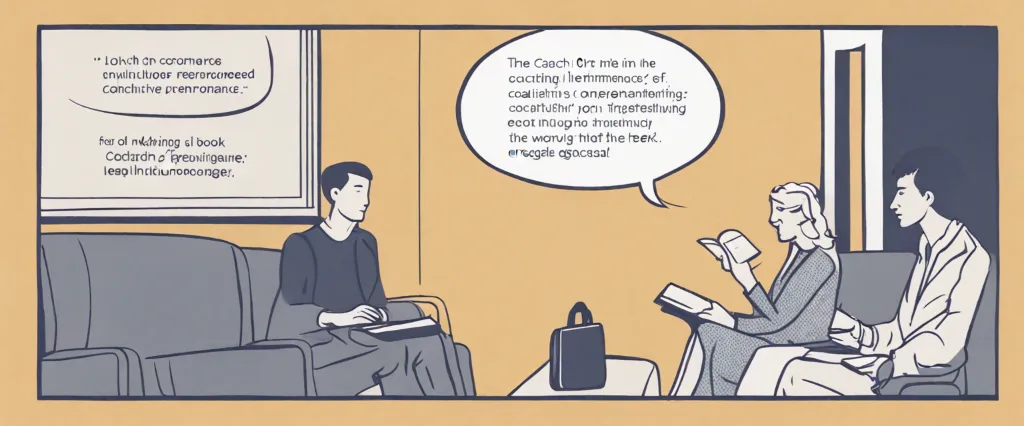
Coaching for Performance by John Whitmore is a renowned book that serves as a blueprint for effective coaching. In this transformative guide, Whitmore provides valuable insights and practical techniques to enhance coaching skills and unleash the potential of individuals and teams. As an accomplished author, coach, and trainer, Whitmore has had a profound impact on the field of coaching, helping countless individuals and organizations worldwide achieve outstanding performance and achieve their goals. Through his extensive experience and expertise, Whitmore demystifies coaching, empowering both coaches and coachees to create lasting positive change within themselves and their organizations.
Chapter 1: The Essence of Coaching
Chapter 1: The Essence of Coaching of the book “Coaching for Performance” by John Whitmore sets the foundation for understanding coaching as a powerful tool for personal and professional development. Whitmore starts by defining coaching, differentiating it from teaching and mentoring, emphasizing that coaching is a facilitative process that empowers individuals to realize their full potential. He argues that coaching is about unlocking a person’s potential to maximize their performance, primarily through raising awareness and encouraging responsibility rather than imparting knowledge or advice.
Whitmore introduces the GROW model, which stands for Goal, Reality, Options, and Willingness. He explains that coaching focuses on setting and achieving goals, exploring the current reality, generating options and possibilities, and forming a commitment to action. By using this model, coaches can guide individuals toward self-discovery and create a sense of ownership and accountability for their progress.
Throughout the chapter, Whitmore highlights the importance of listening and asking powerful questions as key coaching skills. Effective listening allows coaches to understand and connect with individuals at a deeper level, demonstrating empathy and building trust. Asking powerful questions stimulates reflection, challenges assumptions, and helps individuals gain new insights and perspectives.
Furthermore, Whitmore emphasizes the need for coaches to create a safe and non-judgmental environment that encourages individuals to take risks, experiment, and learn from their experiences. He recommends adopting an attitude of curiosity, humility, and respect while celebrating incremental progress and acknowledging the potential for continual growth.
In summary, Chapter 1 lays the groundwork for coaching as a transformative process that helps individuals uncover their potential, set meaningful goals, explore different perspectives, and take responsibility for their actions. By using the GROW model and mastering active listening and powerful questioning techniques, coaches can effectively facilitate personal and professional development.
Chapter 2: The Coaching Mindset
Chapter 2: The Coaching Mindset of the book Coaching for Performance by John Whitmore explores the fundamental principles and mindset required to become an effective coach. Whitmore emphasizes the importance of acknowledging that coaching is about the individual and their personal growth, rather than instructing or giving advice.
The author emphasizes the need for a positive and empowering mindset as a coach. Instead of being fixated on the outcome or result, a coach should focus on the person and their development. This involves understanding their values, needs, and aspirations, and helping them align these with their goals. Whitmore introduces the concept of the “inner game,” which emphasizes the importance of self-awareness and self-belief in order to overcome challenges and achieve success.
Furthermore, the chapter highlights the significance of active listening as a coach. It is essential to fully engage with the coachee, giving them undivided attention and allowing them to express themselves freely. By actively listening, the coach can gain a deeper understanding of the individual’s thoughts, feelings, and perspectives, which enhances the quality of coaching sessions.
Whitmore also introduces the GROW model, a coaching framework that stands for Goal, Reality, Options, and Will. This model helps coaches structure their conversations and guide the coachee towards self-discovery and finding solutions. The GROW model encourages the coach to ask powerful questions that challenge assumptions, generate new insights, and enable the coachee to take ownership of their own learning and development.
In summary, Chapter 2 of Coaching for Performance lays the foundation for effective coaching by emphasizing the importance of a positive mindset, active listening, and the utilization of the GROW model. By adopting this coaching mindset, coaches can support individuals in unlocking their potential, achieving their goals, and experiencing personal growth.
Chapter 3: Establishing a Coaching Relationship
Chapter 3: Establishing a Coaching Relationship of the book Coaching for Performance by John Whitmore focuses on the crucial process of building a strong coaching relationship between the coach and the coachee. Whitmore stresses the importance of trust, rapport, and respect in creating a safe and supportive environment for effective coaching.
The chapter emphasizes that coaching should be a partnership, rather than a one-sided instruction. It encourages coaches to involve coachees in setting goals and to engage in open and honest communication from the beginning. By establishing clear objectives and expectations, both parties can align their efforts towards achieving meaningful results.
Whitmore highlights the power of active listening and empathy. Coaches need to listen attentively, without judgment or interruption, in order to fully understand the coachee’s perspective. By doing so, they can effectively identify and explore any limiting beliefs, assumptions, or fears that may be hindering the coachee’s progress.
The chapter also discusses the importance of challenging assumptions and encouraging self-reflection. Coaches should ask powerful questions to prompt deeper thinking, helping coachees gain insights and new perspectives. This process of self-discovery and reflection enables coachees to take ownership of their development and find their own solutions.
Furthermore, the chapter emphasizes the significance of feedback and praise. Constructive feedback should be provided in a way that is specific, relevant, and focused on behavior rather than personal attributes. Praise and acknowledgment play a vital role in motivating coachees and boosting their confidence.
Lastly, Whitmore emphasizes the need to establish a supportive structure for ongoing coaching. This involves regular sessions, agreed-upon goals, and periodic reviews to track progress. Creating a coaching contract or agreement that outlines roles, responsibilities, and confidentiality can further solidify the coaching relationship.
In summary, Chapter 3 focuses on establishing a strong coaching relationship based on trust, open communication, active listening, empathetic understanding, challenge, and ongoing support. By following these principles, coaches can create an environment conducive to personal growth and development, enabling coachees to realize their full potential.
Chapter 4: Active Listening and Powerful Questions

Chapter 4 of “Coaching for Performance” titled “Active Listening and Powerful Questions” by John Whitmore focuses on two crucial skills that coaches must develop in order to effectively support their clients – active listening and asking powerful questions.
Active listening involves fully concentrating on what the speaker is saying, understanding their message, and responding appropriately. It requires eliminating distractions, suspending judgment, and giving the speaker undivided attention. Coaches practice active listening to establish rapport, retain information, and show empathy towards their clients. Active listening also helps coaches pick up on underlying emotions and concerns, allowing them to address the client’s unspoken needs.
Powerful questions, on the other hand, are thought-provoking and open-ended, encouraging clients to think deeply and explore their own ideas. Rather than providing answers, coaches use these questions to stimulate reflection, shift perspectives, and encourage personal growth. Whitmore emphasizes that open-ended questions such as “What options do you see?” or “What would you do differently next time?” allow clients to discover their own solutions and tap into their own intuition. He also highlights the importance of being patient and comfortable with silence, giving clients time to process and respond.
By combining active listening with powerful questions, coaches can help clients gain new insights, broaden their perspectives, and take ownership of their own development. Instead of providing advice or solutions, coaches act as catalysts, facilitating their clients’ growth and transformation. Whitmore emphasizes that the coach’s role is to support and challenge, rather than instruct or dictate. Through active listening and powerful questions, coaches create a safe and supportive space for clients to discover their own potential and take meaningful action towards their goals.
Chapter 5: Setting Goals and Creating Action Plans
Chapter 5 of the book “Coaching for Performance” by John Whitmore focuses on setting goals and creating action plans. The chapter highlights how clear goals and well-defined action plans are essential for individuals and organizations to achieve success.
The chapter begins by emphasizing the importance of goals as guidelines for coaching. Goals provide direction and motivate individuals to strive for better performance. Whitmore emphasizes that goals should be specific, measurable, achievable, relevant, and time-bound (SMART). By setting SMART goals, individuals can better understand what they are working towards and can track their progress effectively.
The author emphasizes the role of the coach in helping individuals set meaningful goals. The coach should facilitate a collaborative process, encouraging the individual to identify their aspirations, desires, and potential. The coach also assists in clarifying goals, ensuring they align with the individual’s values and motivations.
Whitmore introduces the GROW model as a practical tool for setting goals and creating action plans. The GROW model stands for setting Goals, exploring Reality, considering Options, and creating the Will to take action. Through each step, the coach helps the individual gain clarity, evaluate the current reality, brainstorm and evaluate potential options, and commit to a specific course of action.
The chapter also addresses the importance of developing action plans that outline the steps required to achieve goals. Whitmore emphasizes breaking down goals into manageable tasks with specific deadlines. He emphasizes that action plans should consider the resources, skills, and support required for success.
In conclusion, Chapter 5 of “Coaching for Performance” emphasizes the significance of goal-setting and action planning for individuals to excel in their personal and professional lives. The GROW model serves as a practical guide, while the coach plays a crucial role in facilitating the process and ensuring goal alignment with values and aspirations.
Chapter 6: Giving Effective Feedback
Chapter 6 of “Coaching for Performance” by John Whitmore delves into the importance of giving effective feedback in the coaching process. Whitmore emphasizes that feedback is essential for the growth and development of individuals, as it helps them identify their strengths, areas for improvement, and understand the impact of their actions.
The chapter begins by outlining the key principles of effective feedback. Firstly, feedback should be specific and focused on behavior rather than personality traits. It should highlight both positive aspects and areas in need of improvement, in a balanced and constructive manner. Secondly, feedback should be timely, delivered as close to the observed behavior as possible to ensure accuracy and relevance. Furthermore, it is crucial to consider individual preferences and styles when providing feedback, tailoring it to the needs and personality of the recipient.
Whitmore also emphasizes the importance of feedback being offered in a supportive and non-threatening manner. The intention should be to help the individual understand their impact, not to criticize or judge. This requires skillful questioning techniques to guide their own self-reflection and analysis.
The author includes practical tips on giving feedback effectively. These include using specific examples, avoiding generalizations, and using clear and concise language. It is important to focus on behaviors that can be changed rather than on characteristics that are more difficult to alter. Additionally, feedback should be focused on facts rather than opinions, ensuring objectivity.
Overall, Chapter 6 provides valuable insights into providing meaningful feedback in the coaching process. It emphasizes the importance of timely, specific, and constructive feedback that helps individuals gain self-awareness, enhance their performance, and foster their personal development.
Chapter 7: Overcoming Barriers and Challenges
Chapter 7 of “Coaching for Performance” by John Whitmore focuses on overcoming barriers and challenges that coaches may encounter in their coaching practice. The chapter emphasizes the importance of self-awareness, communication skills, and flexibility in facing these obstacles.
One of the main barriers discussed in the chapter is the coach’s own limiting beliefs. Whitmore highlights that coaches should be aware of their biases, assumptions, and prejudices that may hinder the coaching process. By recognizing and challenging these beliefs, coaches can become more open-minded and create a supportive environment for their clients.
Another challenge mentioned is the fear of vulnerability and risk-taking. Coaches should encourage their clients to step out of their comfort zones and explore new possibilities. Similarly, coaches themselves need to be willing to take risks and be vulnerable, sharing their own experiences and insights as appropriate.
Communication is highlighted as a vital skill for coaches to overcome barriers. Effective listening, asking powerful questions, and providing constructive feedback are emphasized as crucial elements in facilitating meaningful coaching conversations. Additionally, coaches must adapt their communication style to suit each individual client, as everyone has different needs and preferences.
The chapter also addresses the importance of working with resistance and difficult clients. Whitmore suggests that coaches should view resistance as an opportunity for growth and understanding. By building trust and rapport with clients and exploring their underlying fears and concerns, coaches can help them overcome resistance and make positive changes.
In summary, Chapter 7 of “Coaching for Performance” provides valuable insights into overcoming barriers and challenges in coaching. Coaches are encouraged to be self-aware, open-minded, and adaptable in their approach. Effective communication skills, managing resistance, and embracing vulnerability are highlighted as crucial factors in supporting clients to reach their full potential.

Chapter 8: Sustaining Growth and Development
Chapter 8 of the book Coaching for Performance by John Whitmore, titled “Sustaining Growth and Development,” explores the process of maintaining and enhancing personal and professional growth over time. Whitmore delves into the importance of self-awareness, responsibility, and learning as key elements in this process.
The chapter begins with a focus on self-awareness as the foundation for sustaining development. Whitmore emphasizes the need for individuals to continuously reflect on their thoughts, emotions, and behaviors, enabling them to gain a deeper understanding of themselves. By developing self-awareness, individuals can identify their strengths, areas for improvement, and the impact they have on others.
Taking responsibility is presented as another crucial aspect in the journey toward sustained growth. Whitmore asserts that individuals must take ownership of their actions and their impact on their own development. Rather than blaming external circumstances or other people, individuals are encouraged to recognize that they have the power to make choices and shape their own path.
Whitmore also emphasizes the importance of ongoing learning. He highlights that in order to sustain growth, individuals must embrace a mindset of continuous improvement. This involves seeking new knowledge, acquiring new skills, and being open to feedback and constructive criticism.
The chapter concludes with the understanding that sustaining growth and development is a lifelong process requiring dedication and commitment. Whitmore stresses the significance of setting clear goals and regularly reviewing progress to ensure continuous growth. He also encourages individuals to seek support from mentors or coaches who can provide guidance and accountability.
Overall, Chapter 8 highlights the importance of self-awareness, responsibility, and continuous learning in sustaining growth and development. It provides practical insights and tools for individuals to create a proactive approach to their personal and professional growth journeys.
After Reading
In conclusion, “Coaching for Performance” by John Whitmore provides a comprehensive understanding of the coaching process and its transformative impact on individuals and organizations. The book emphasises the importance of empowering others to unlock their potential through effective communication, active listening, and thoughtful questioning. It offers valuable insights into the key principles and techniques of coaching, highlighting the significance of goal setting, feedback, and continuous learning. Throughout the book, Whitmore presents numerous real-life case studies and practical examples that illustrate the power of coaching in fostering personal and professional growth. Ultimately, “Coaching for Performance” serves as a valuable resource for aspiring coaches, managers, and leaders who aim to cultivate a culture of excellence, self-awareness, and sustainable success.
1. The Fifth Discipline: The Art and Practice of the Learning Organization” by Peter M. Senge – This classic book explores the concept of a “learning organization” and its benefits for businesses. Senge provides valuable insights on system thinking, personal mastery, mental models, and more, guiding leaders towards transformational approaches to management.
2. Everything is Negotiable: How to Get the Best Deal Every Time” by Gavin Kennedy – Building on the principles of effective negotiation, Kennedy presents a comprehensive guide to mastering the art of negotiation. Through practical examples and strategies, this book equips readers with valuable techniques for achieving win-win outcomes in any negotiation scenario.
3. The Effective Executive: The Definitive Guide to Getting the Right Things Done” by Peter F. Drucker – A timeless classic, Drucker’s book offers indispensable advice for today’s executives. Focusing on key leadership practices, he emphasizes the importance of time management, decision-making, communication, and effective delegation, empowering leaders to maximize their productivity and impact.
4. Drive: The Surprising Truth About What Motivates Us” by Daniel H. Pink – Based on extensive research, Pink challenges conventional wisdom regarding motivation and offers a new framework for understanding what truly drives individuals. Exploring the concepts of autonomy, mastery, and purpose, this book provides valuable insights into creating an engaging and fulfilling work environment.
5. Leaders Eat Last: Why Some Teams Pull Together and Others Don’t” by Simon Sinek – In this compelling read, Sinek explores the role of leadership in fostering a positive and collaborative team culture. By examining the inherent human need for trust and safety, the book provides actionable advice on building strong teams, enhancing productivity, and inspiring individuals to contribute their best.



